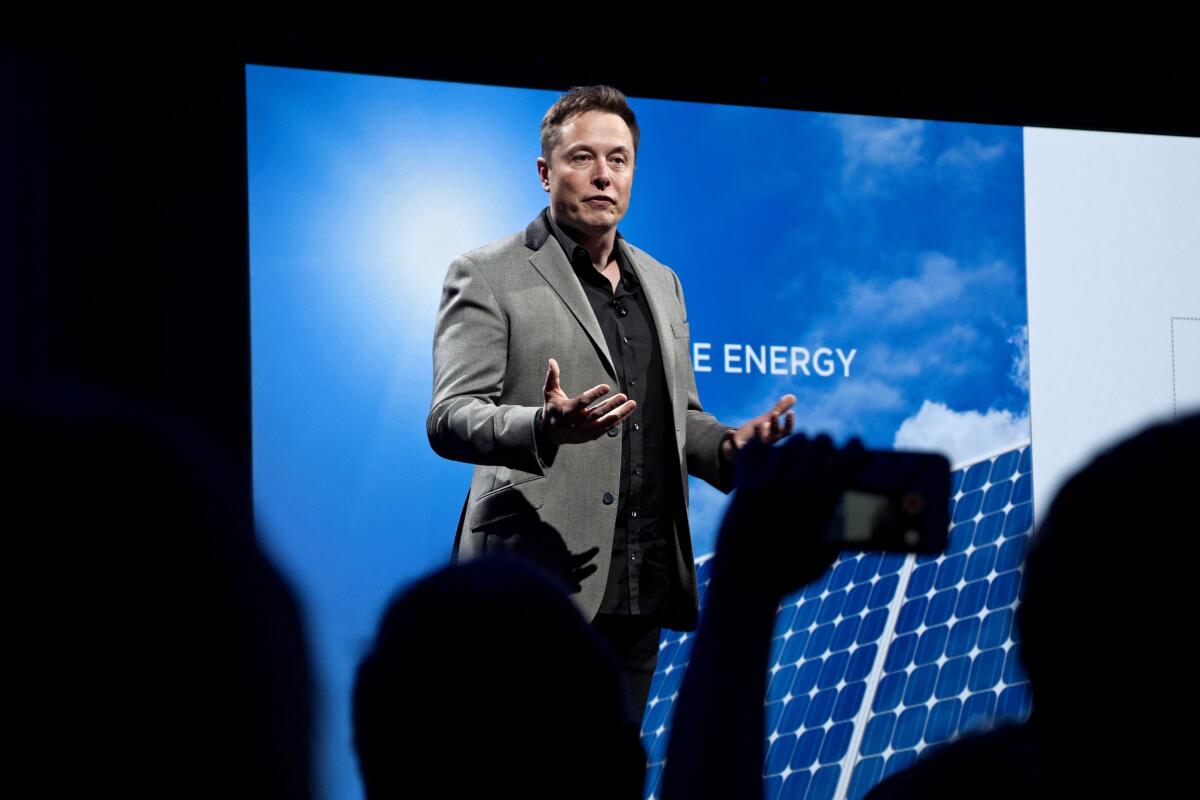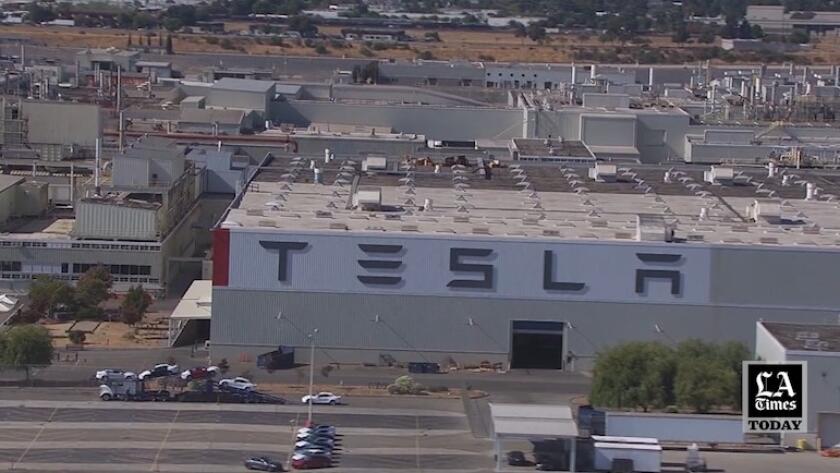Silicon Valley’s tech monopoly is over. Is the future in Austin, Texas?

WASHINGTON — When Tesla announced last fall that it was moving its corporate headquarters from California to Texas, officials in Sacramento seemed more surprised than concerned.
After all, Tesla was expanding its sprawling Fremont, Calif., assembly plant, which already employs thousands of people. It’s building a battery factory in the Northern California town of Lathrop.
And real estate brokers say the company is leasing more office space in Palo Alto, where its corporate headquarters had been located since 2009. Tesla was founded in nearby San Carlos in 2003.
Yet the decision by the electric vehicle pioneer’s chief executive, Elon Musk, to move Tesla’s headquarters to the Texas state capital of Austin may signal gathering clouds on the horizon of California’s economic future.
For the present, things are still looking bright for the state. Sacramento has been enjoying unprecedented growth in revenues, thanks in large part to high capital gains taxes paid by the superrich in Silicon Valley.
And in a measure of California’s present hold on the tech sector, the Golden State remains far and away the leader in raising venture capital.
For years, California has suffered a net out-migration of people to Texas. But the losses in population tended to be at the lower end of the socioeconomic scale and the state has grown steadily richer despite the large outflows of people.
What worries some economists and other analysts is that this favorable pattern may be starting to change.
Tesla was one of an accelerating number of California companies, including other big tech names such as Oracle and HP Enterprise, that have relocated headquarters to Texas.
“I believe this is just the tip of the iceberg,” said Dan Ives, who has been covering the tech sector for more than two decades, and is currently managing director at Los Angeles-based Wedbush Securities. He said 20% of the companies he follows are considering relocating or opening a second headquarters outside of California.
Stanford’s Hoover Institution tallied 74 such company moves out of the state in the first half of last year, more than all of 2020 and higher than the comparable period in each of the prior two years. Researchers cited a litany of factors for the change: the rising cost of living in California, a tax structure and labor policies that many corporate leaders see as unfriendly, and concerns that the quality of life is declining.
In the case of Tesla, which last month also started producing vehicles near Austin, the decidedly conservative views of its multibillionaire boss may have made Texas an appealing base. Musk personally moved there in 2020.
The state’s net population loss to Texas, the top destination for migrants, last year was about double the pace of the last decade, according to credit data analyzed by Moody’s Analytics. Some kept their California jobs, thanks to new remote work opportunities. Others started new businesses in Texas.
To be sure, the Bay Area has such a deep reservoir of tech talent, money and infrastructure, not to mention the climate and the ocean, that it won’t be easily knocked off its perch.
First-generation tech firms Apple, Cisco, Intel, Hewlett-Packard, among others, are still in the Bay Area, as are newer tech icons Facebook, Google and Netflix.
And Stanford and Berkeley are key generators of talent, research and new ideas for Silicon Valley’s ecosystem.
But California’s tech hub today seems to be facing what beset Hollywood years earlier, when Canada and states such as Georgia, where Marvel does much of its shooting nowadays, lured away film production from Los Angeles with numerous incentives.
“The Silicon Valley has lost its monopoly on opportunity, and now it has to compete,” said Patrick McKenna, founder of One America Works, which connects talent with new tech communities. “It has to compete with other locations to attract the talent that’s going to build the future.”
McKenna spent 15 years in the Bay Area as an entrepreneur and investor, but in 2019 moved to Austin. He saw opportunities in central Texas, but also rued the fact that many people in the Bay Area were getting left behind in the tech boom.
Of the state’s record budget surpluses, McKenna said: “California is flush right now because it’s harvesting an investment that happened 10 years ago.”
Increasingly he sees other states and nations cutting into California’s share of the technology industry.
Economic officials at California Gov. Gavin Newsom’s office say it’s natural that as companies such as Tesla grow to become world leaders, they will expand elsewhere to be closer to markets and supply chains and to extend their global footprint.
Businesses will continue to leave California just as they have for decades, these officials argue, but there are good reasons why firms were born and incubated in the state, and why more will come and start new ventures and take companies public, creating more wealth and more jobs.
“The idea that the California economy is imperiled is not borne out by the numbers,” said Dee Dee Myers, a former White House press secretary for President Clinton. She is now Newsom’s director of business and economic development.
It’s true that in tech, no city or state comes close to the Bay Area in the amount of new venture capital — $120 billion last year, a figure that until 2018 was more than the rest of the country combined, said Kyle Stanford, a senior analyst at PitchBook, a Seattle-based financial data and software firm that tracks private capital markets.
In terms of number of venture capital deals, despite growth elsewhere, the Bay Area’s share held firm last year — topping 20% as it has every year since at least 2006. That’s important because companies tend to start or set up fairly close to where the lead investor is based, which buys the Bay Area some time.
But, Stanford says, “there’s definitely a risk of losing major emerging companies when you have these large tech giants move out. You’re going to see engineers from Tesla probably create new companies in Austin, and those are companies that are going be lost in the Bay Area.”
Moreover, while in the popular imagination Texas remains a vast landscape of cowboys, oil and conservative politics, the reality is more complex: The state’s universities have built up stronger reputations in engineering and other specialties prized by corporations.
And Austin, whose unofficial motto is “Keep Austin weird,” demonstrates at least some parts of the state are becoming culturally compatible with Californians.
Nor can Silicon Valley count on people coming from overseas to make up the loss.
Foreign-born students, researchers and entrepreneurs have been a big part of California’s tech boom, but the unwelcoming immigration policies under former President Trump, plus lingering effects of the COVID-19 pandemic, and cold-war-like relations with China, have had chilling effects.
Then there’s California’s high cost of living, particularly housing.
In the Bay Area, the typical home now fetches a median price of $1.2 million, which is more than double the cost in Austin, despite the rapid rise in home values there. The cost of housing in Dallas is one-fourth the price in the Bay Area.
Brett Arnold, 35, an accountant and lifelong California resident, and his wife, Jamie, moved to a town about an hour north of Dallas last July, primarily because of the difference in the cost of living.
The couple had both worked in Orange County to keep up financially, but she wanted to stay at home with their 4-year-old. So last April, the Arnolds sold their Rancho Santa Margarita townhome for $730,000 and bought a much larger 2,800-square-foot house in Prosper, Texas, for $570,000.
“The quality of life has gone up,” Brett Arnold said.
For now at least, Austin’s share of the nation’s venture capital, tech startups and revenues pales next to the Bay Area. But it is rising, thanks in good part to Silicon Valley.
Meta, formerly Facebook, is leasing 33 floors in what will soon be the city’s tallest building. Oracle is estimated to have 2,500 employees currently at its campus near Lady Bird Lake, and local reports say it’s buying nine more acres nearby, enough to house well over 10,000 workers.
Amid the pandemic in 2020, as Oracle announced its headquarters move, the company said it would take “a modern approach to work that gives our employees more flexibility to choose where and how to work.”
No one knows how many from Tesla have moved with Musk, although some, including Valerie Workman, head of human resources and one of its highest-ranking Black employees, have since left the company.
Musk, in his characteristically flamboyant style, said its Texas operations could scale up to 20,000 employees. Its Austin-area factory has the potential to produce three times as many vehicles as the Fremont facility, said Ives of Wedbush.
Over the next 18 to 24 months, Ives said, Tesla is likely to move the R&D and design operations now in Palo Alto to Austin.
“They could find engineers 50% cheaper in Austin than in the Silicon Valley,” he said. And such a move would bring the company’s brain trust close to where Musk himself lives.
Plus, that’s what many employees may prefer, to settle in semi-remote places where they can enjoy a higher standard of living. It’s partly why Tesla’s Irvine-based rival, Rivian, is producing its vehicles in northern Illinois and outside Atlanta, analysts say.
Intel is building its new chip factory in Columbus, Ohio. Other tech firms are going to Nashville.
“California and the Valley always will have an allure geographically that can’t be matched,” Ives said, “but now you’re starting to see alternatives.”
Joel Kotkin, a fellow at Chapman University and longtime analyst of demographic, social and economic trends in California, worries especially about the state’s heavy dependence for tax dollars from tech IPOs and the super-wealthy to pay for progressive but expensive policies — such as for the environment and the social safety net.
In 2019, the top 1% of taxpayers in California paid about 45% of personal income taxes, which make up about two-thirds of the state’s entire general fund revenues.
In a report with colleague Marshall Toplansky, Kotkin wrote that the losses of company headquarters have eroded the state’s economic diversity and opportunities for upward mobility for the middle class.
“In the aggregate we could look good because Apple computer by itself makes you look good,” Kotkin said in an interview. “If we continue this gusher of tech money, we could just continue to subsidize the vast majority of the population and maybe won’t collapse,” he said.
But what happens if that cornucopia of tax money begins to shrink?
“We could either restore California’s promise as a land where people go and their lives are improved,” he said, “or we could become some sort of high-tech feudal state, which is where we’re headed.”
Watch L.A. Times Today at 7 p.m. on Spectrum News 1 on Channel 1 or live stream on the Spectrum News App. Palos Verdes Peninsula and Orange County viewers can watch on Cox Systems on channel 99.
More to Read
Get the L.A. Times Politics newsletter
Deeply reported insights into legislation, politics and policy from Sacramento, Washington and beyond. In your inbox three times per week.
You may occasionally receive promotional content from the Los Angeles Times.












